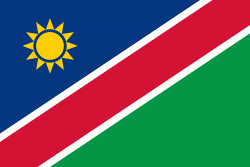Namibian dollar
$
The Namibian dollar (symbol: N$; code: NAD) has been the currency of Namibia since 1993. It is normally abbreviated with the dollar sign $, or alternatively N$ to distinguish it from other dollar-denominated currencies. It is divided into 100 cents.The dollar replaced the South African rand, which had been the country's currency while it was under South African rule as South-West Africa from 1920 until 1990, at par. The rand is still legal tender, as the Namibian dollar is linked to the South African rand and can be exchanged on a one-to-one basis locally. Namibia was also part of the Common Monetary Area from independence in 1990 until the introduction of the dollar in 1993.
In the beginning, alternative names for the Namibian dollar were suggested, including Namibian kalahar, referencing the Kalahari Desert in the east of Namibia, but ultimately the government settled on the name Namibian dollar. The first notes were issued on September 15, 1993.
The Bank of Namibia issued the first banknotes on 15 September 1993 and, in December, issued the first national coins.
Country
-
Namibia
Namibia, officially the Republic of Namibia, is a country in Southern Africa. Its western border is the Atlantic Ocean. It shares land borders with Zambia and Angola to the north, Botswana to the east and South Africa to the south and east. Although it does not border Zimbabwe, less than 200 metres (660 feet) of the Botswanan right bank of the Zambezi River separates the two countries. Namibia gained independence from South Africa on 21 March 1990, following the Namibian War of Independence. Its capital and largest city is Windhoek. Namibia is a member state of the United Nations (UN), the Southern African Development Community (SADC), the African Union (AU) and the Commonwealth of Nations.
The driest country in sub-Saharan Africa, Namibia has been inhabited since pre-historic times by the San, Damara and Nama people. Around the 14th century, immigrating Bantu peoples arrived as part of the Bantu expansion. Since then, the Bantu groups, the largest being the Ovambo, have dominated the population of the country; since the late 19th century, they have constituted a majority. Today Namibia is one of the least densely populated countries in the world.
